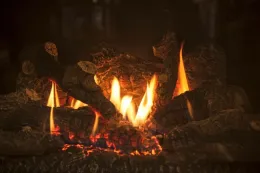
Residential wood burning is the largest single source of particulate matter pollution in the Valley during winter months. For this reason, the District's residential wood smoke reduction program imposes restrictions on the use of fireplaces, wood stoves, fire pits and chimneys. The District recommends using other methods to heat your home unless wood burning is your sole source of heat. For full details on the District's Residential Wood Smoke Reduction Program, visit www.valleyair.org/rule4901.

Another source of air pollution are small engines on gas-powered yard care equipment, which have no emission controls. One gas-powered lawn mower can pollute as much as 12 late-model cars.
For every gas-powered lawn or garden tool, there is an electric or manual alternative that works just as well.
The District's Clean Green Yard Machines yard care incentive program provides significant rebates on electric lawn mowers, trimmers, edgers, pole saws and chain saws. For details on these incentives visit www.valleyair.org/cgym.
In addition, the Valley Air District suggests using a rake or broom instead of a blower. Leaf blowers create particulate matter in the form of dust and can be a nuisance to your neighbors.
Anthony Presto is the Outreach & Communications Representative for the San Joaquin Valley Air Pollution Control District

